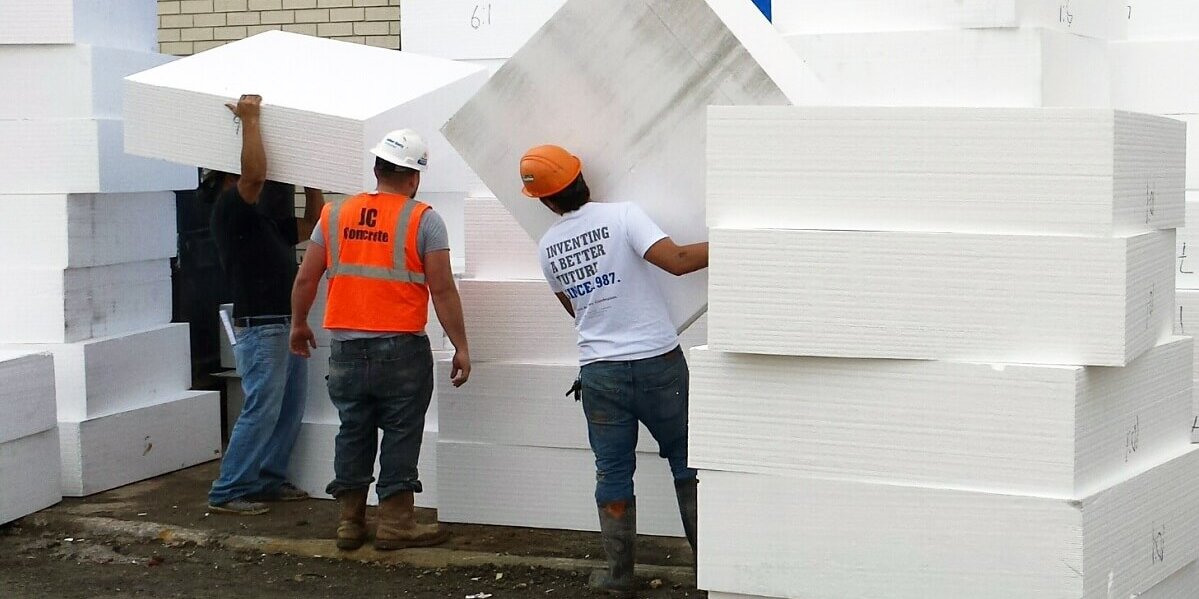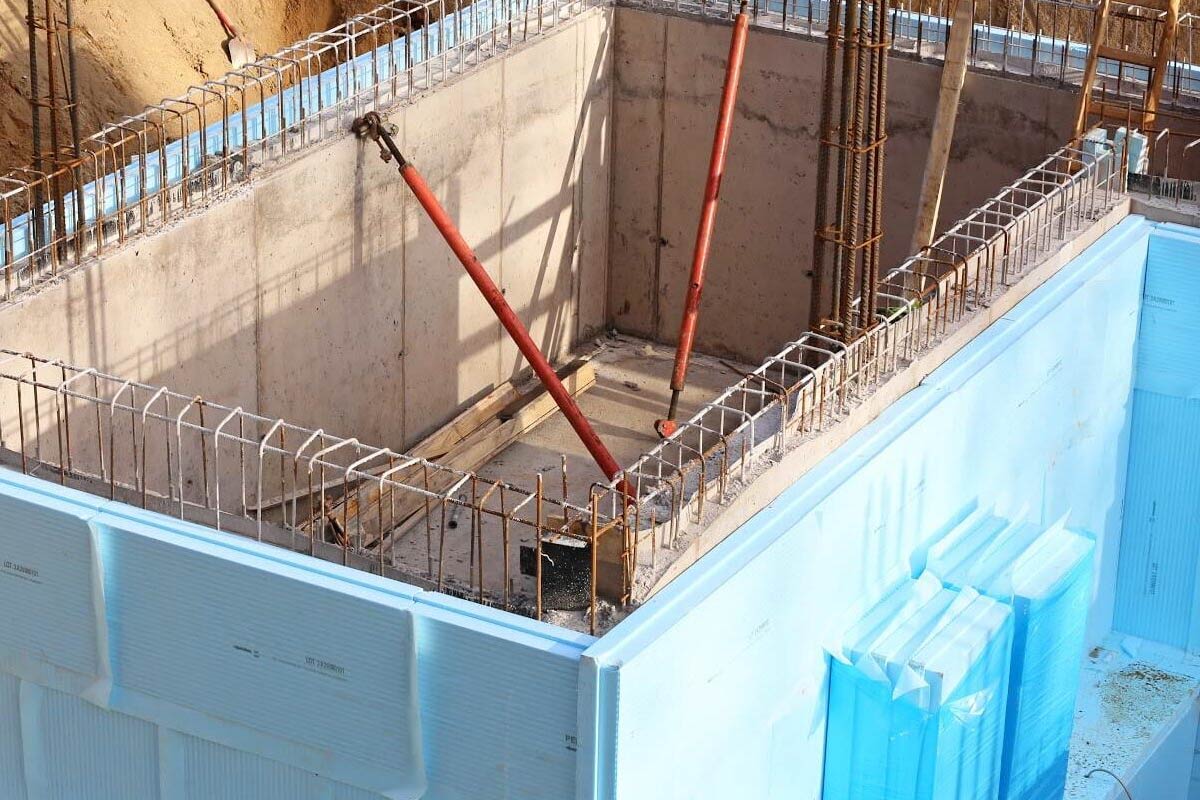#1 What is EPS geofoam?
EPS geofoam, or expanded polystyrene, is an extremely lightweight non-traditional building material. It weighs only one pound per cubic foot and has a low density combined with a high strength that makes it the perfect building material for many geotechnical applications. EPS geofoam is made from polystyrene resin beads via a process called polymerization. During this process, the beads are placed in a mold and heat and pressure are applied. By controlling the amounts of heat and pressure applied, EPS geofoam can be created in a variety of densities. Its closed-cell structure makes EPS geofoam water-resistant and it won’t rot or deteriorate over time. Under normal conditions, EPS geofoam is virtually maintenance-free. Because it is 98% to 99% air by volume, EPS geofoam is also a highly efficient thermal insulator. Unlike Styrofoam, however, EPS geofoam is 100% recyclable and environmentally friendly.
EPS geofoam is a very versatile building material that works well for many different applications such as road construction, bridge abutments, slope stabilization, building foundations, retaining walls, stadium and theatre seating, fill for underground utilities and landscaping.
#2 How long has EPS geofoam been used in the construction industry?
EPS geofoam was first developed in Germany in the 1930s. But it wasn’t until the early 1970s that it was first used for a construction application. That first project was the Flom Bridge in Oslo, Norway. The second major EPS geofoam construction project took place in Japan with the runway expansion of Tokyo International Airport (now known as Narita International Airport).
The United States didn’t jump on the EPS geofoam bandwagon until the late 1980s. In 1989 EPS geofoam blocks were used as fill to stabilize and support the embankment on a stretch of Highway 160 in Colorado. Around the same time, EPS geofoam blocks were used for utility insulation and protection in the installation of the Trans Alaska Pipeline and for embankment and utility protection for Utah’s Highway I-15 project. The I-15 project used approximately 3.53 million cubic feet of EPS geofoam and currently remains the largest documented EPS geofoam project in the U.S.
EPS geofoam continued to generate high interest among engineers, architects and general contractors, resulting in its increased usage in the construction industry. In 2005, the ASTM D6817 standard was created specifically for geofoam. The following year, the Federal Highway Commission designated EPS geofoam as the go-to product for lightweight fill projects on a tight deadline.
Today, EPS geofoam is recognized as a mature technology. It has gained wide acceptance worldwide and has become the product of choice for many applications such as bridge embankments, stadium seating platform construction and slope stabilization. MarketsandMarkets™, a provider of B2B research on high growth emerging opportunities, anticipates the geofoams market (EPS and XPS geofoam) to grow from $796 million in 2019 to 1,069 million by 2024!
#3 What is the EPS geofoam construction method?
There are many benefits of using EPS geofoam over more traditional construction materials. EPS geofoam blocks weigh only 1% the weight of soil and less than 10% the weight of other lightweight traditional fills. They are up to 100 times lighter than other traditional fills with comparable compression strengths. Since EPS geofoam blocks are such a lightweight material, they can help reduce settlement and provide increased stability against bearing and slope failures.
Using EPS geofoam blocks to support retaining walls, bridge abutments or foundation walls results in a significant reduction of lateral stress and weight on the structure. And, EPS geofoam’s high compressive strength of up to 60 psi provides increased durability over the lifetime of the structure.
The light weight of EPS geofoam makes it much easier to handle and install. A construction project using EPS geofoam will typically require less time and labor than the same construction project using traditional construction methods.
EPS geofoam is a non-traditional building material that can significantly reduce onsite construction times and project costs. As such, it has become a favored lightweight fill material for road construction, bridge construction, accelerated methods of construction and projects that are on the fast-track.
#4 How is EPS geofoam handled and installed?
The main thing to note is that no heavy machinery is required. EPS geofoam blocks are extremely lightweight, weighing only one to two pounds per cubic foot. Your construction crew can easily hand-carry them and place them into position, staggering the blocks so the seams aren’t continuous and interlocking them. The construction process isn’t complicated. It requires only a brief training period for construction workers to master the tecnique.
Since blocks can be factory manufactured to size for your project, there’s little to no retrofitting involved. But EPS geofoam can easily be shaped onsite, via hot wire or chain saw, to accommodate plan changes and on-the-fly tweaks.
Because it can be handled and installed so easily, using EPS geofoam blocks can cut weeks off your construction schedule. That can enable you to complete your project on time or even ahead of schedule. Plus, there are cost savings involved. The ease of installation means fewer construction workers are required onsite. You won’t have to use heavy equipment and transportation costs will be significantly lower compared to traditional materials when you use EPS geofoam. Those factors can significantly increase your overall savings.
Another thing to consider is the safety factor. Since there’s no heavy equipment involved and fewer construction workers onsite for less time during the installation, there’s less opportunity for workers to get injured on the job. And that can save a contractor’s reputation as well!
#5 How much weight can EPS geofoam carry?
The compression standard of ASTM C578 is based on 10% deformation for Type 1 EPS geofoam. It calls for a strength of 10psi or 1,440 pounds per square foot. In other words, one square inch of Type 1 EPS geofoam can maintain all its ASTM C578 properties and support 10 pounds even when compressed to 90% of its original thickness. That same one square inch of Type 1 EPS geofoam can support 1,440 pounds if you place a board measuring one square foot on top of it.
If you need to retain 1% or less deformation, one pound of EPS geofoam will support 3.5 pounds per square inch. For example, 100 square feet of Type 1 EPS geofoam is able to support 50,400 pounds with 1% deformation. That’s the weight of approximately 12 cars! This high compressive strength is what makes geofoam extra durable and resistant to damage.
EPS geofoam’s strength is even more amazing considering it is so lightweight. EPS geofoam blocks weigh in at only one to two pounds per cubic foot, depending on size. That makes them up to 100 times lighter than other traditional fills with similar compressive strengths.
#6 Can EPS geofoam be recycled?
Yes. In 2016 more than 118.7 million pounds of EPS geofoam was recycled in the U.S. And that figure just keeps growing. EPS geofoam is made from polystyrene polymer in the form of resin beads. It is 100% recyclable and can be heated and reformed indefinitely. Shredded and re-ground EPS geofoam waste can be added to the pre-puff (formed by heating the resin) in the manufacturing process and used to create new EPS geofoam blocks.
EPS geofoam is also being recycled into a variety of new products by businesses all around the globe. These products include, insulated cups, foam food containers, roofing tiles, coat hangers, door and window frames, outdoor furniture and more.
There are several methods for recycling EPS geofoam. You can grind and de-dust used EPS geofoam to create dust blocks or densify EPS geofoam waste/scraps into solid logs or blocks by extrusion. EPS geofoam can also be recycled by mixing it with a solvent that breaks it down into a material with the properties of virgin polystyrene.
#7 Does using EPS geofoam have an environmental impact?
EPS geofoam is one of the most environmentally responsible building materials you can use in your construction project. No potentially harmful greenhouse gases are used in the manufacturing process and the product doesn’t emit greenhouse gases. It’s free of dyes, formaldehyde, chloroflure carbons (CFCs) and hydrochlorofluorcarbons (HCFCs). EPS geofoam blocks are manufactured using primarily steam, and the water from the manufacturing process is collected and reused. The blocks can be manufactured using up to 10% of recycled materials and the product itself is 100% recyclable. And, since EPS geofoam blocks are a manufactured product, every time you use EPS geofoam in a project instead of a natural material such as rock or timber, you are helping to sustain the environment.
EPS geofoam blocks are so lightweight, less fuel is consumed in transporting them to the jobsite. In addition, heavy machinery isn’t required for installation, so potentially less fuel is consumed on EPS geofoam projects. And, since using EPS geofoam can shorten construction time significantly, there’s less impact to the environment surrounding the project.
In addition, EPS geofoam is not biodegradable. It will not leach into the ground over time, adversely effecting soil and groundwater quality. That’s important, as more and more customers are looking for construction projects that use eco-friendly products.
EPS geofoam is a great thermal insulator and can help reduce energy consumption. Buildings constructed with EPS geofoam blocks can keep the building cooler in the hot summer months and warmer in the cold winter months, making the building more economical to maintain throughout the lifetime of the building.
So, EPS geofoam has a positive impact beginning with the manufacturing process, and continuing during transport to the job site, at the construction site, throughout the lifetime of the finished construction project and when it is recycled to produce new products.






